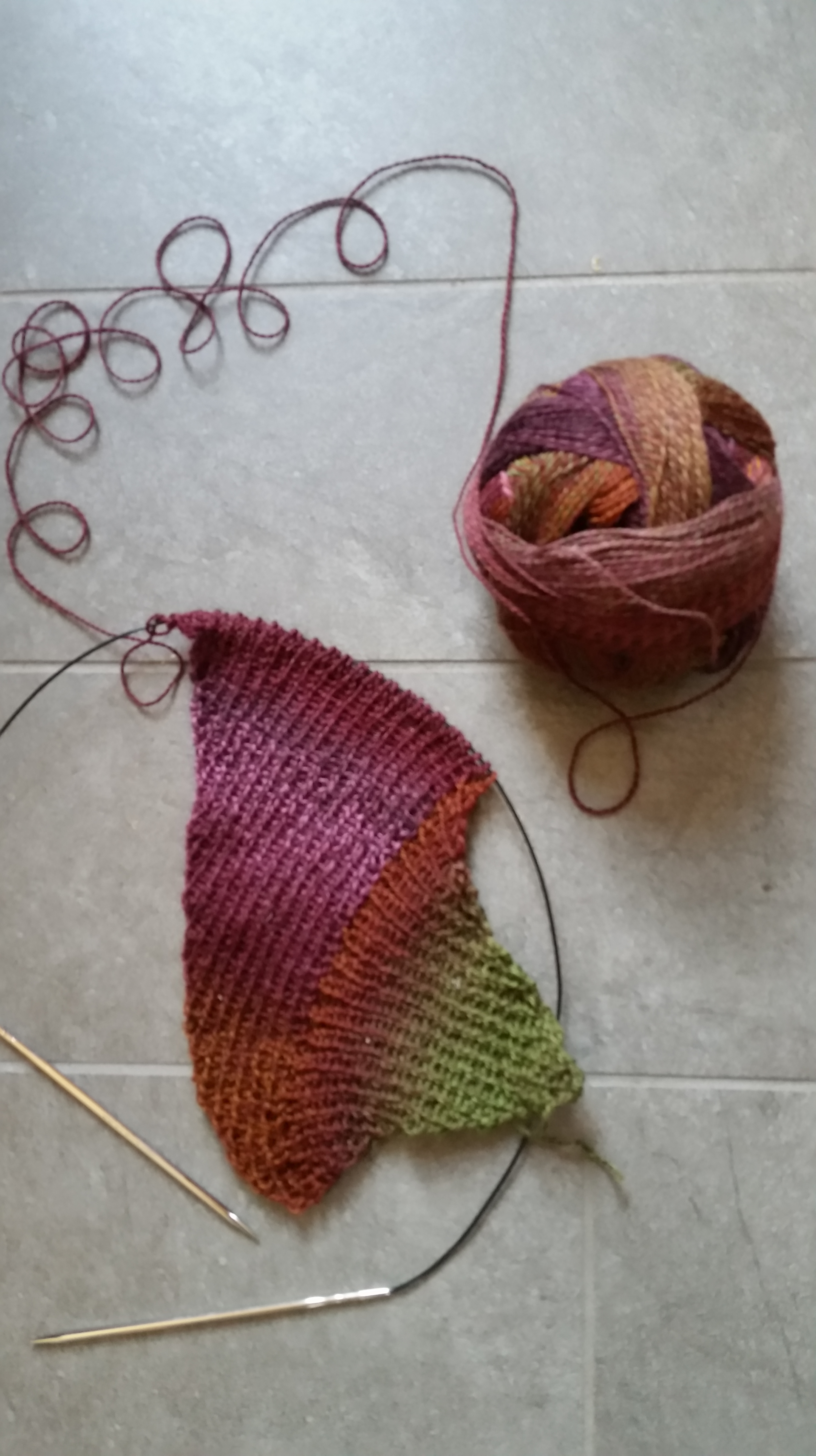SCREAMING TO ANOTHER FINISH
And here’s another finish!
This was a super quick project, barely a week from cast-on to final block. Even though I still have a couple of ends to tuck in, I consider it done.

Younger Daughter bespoke this, having noted the popularity of screaming yellow this Fall season, and a similar trend towards heavier, highly textured knits.
This shoulder/mini shawl is done in machine washable Merino sport weight, from Gems. I used the May Day Shawl pattern by Zabeth Loisel-Weiner, available for free on Ravelry. It took about 2.3 skeins of the yellow. I consider it a very simple project – the instructions and charts were spot on, and very clear. Lots of “bang-for-the-buck” here in terms of visual complexity vs. effort invested. If you are looking for a first serious lacy knitting project, this is not a bad place to start.
That being said, I have to say I detest knitting bobbles and nupps. These are bobbles. I tamed them somewhat by knitting backwards – that is learning to work the back-again bit of each bobble working off of my right hand needle, so I didn’t have to flip the work over to purl back in the middle of each little bump. If you haven’t tried this yet, it’s well worth the learning curve investment for little back-and-forth scraps like bobbles and Entrelac.
A quick word on blocking if I may. Lacy knitting needs to be blocked to within an inch of its life – as tightly as you can. Here’s the before photo, and the mid-block photo:
If you count the 2×2-inch squares of the checked sheet I block on, you can see that pinned out (right), the thing is almost twice as big as it was before pinning (left).
How do I block? I admit I’m not the most precise or assiduous, but I do try, at least a bit to keep things neat and square. The black and white sheet, although an eye-popping Peter Max background is very helpful in estimating and meeting target measurements, and keeping 90-degree angles true. I bought it at a discount/close-out store years ago when shopping for inexpensive bedding for the girls to take to summer camp. I knew that if the sheets survived, they would be perfect for this use. (Plaids, Tattersall checks, and ginghams would also work).
I dampened the knitting, and spread my sheet over an area rug to provide anchorage for my pins. Then I threaded blocking wires across the top of the piece, slipping them into every edge “purl bump.” Then I inserted additional wires along the join line between the edging and the center triangle. I pinned the top wire down first, spreading the work along its length, then stretched the piece down the spine, pinning the pointed junction of the two side wires. Then I pinned the side wires out as far as I could manage, making sure to keep the angles (as measures vs. the checks) true. I had to jockey and adjust them a few times, but eventually I was satisfied. Then and only then did I place a single pin at each of the edging’s points. If I had started with the edging points, the center triangle would have been deformed. Using the wires keep the piece from developing internal “scallops” corresponding to the pins placed in the edging.
No lie – it is tedious. But it’s worth it.

Now on to other things.
I say goodbye to this tiny little embroidered scrap. It’s the finest gauge I ever worked – over 38 stitches per inch on 80-ish or so count muslin, using standard black sewing thread:
It started out as an experiment, to see if I could do a coif at that gauge. Soon after I got started it met with an accident, and was never finished. That was about 35 years ago, easily. Why goodbye? I’ve mailed it off to become part of A Larger Project. The East Kingdom doll project was on display at the 50th anniversary, and still lives. About the only thing people remember me for is that I embroidered, so I am sending this snippet to the curators/creators to be a prop for the doll that represents me. Maybe they’ll make a tiny flat frame for it. That would be sweet. Pix if I get some, I promise.
And finally, another start. I have two balls of precious multi-color yarn – rather pricey Schoppel Zauberball Crazy fingering weight. I adore just looking at them. But it was time to put at least one to good use. So I began casting around for something fun to do with the very long repeat. I’ve tried a lot of the popular projects that use Zauberball. And I didn’t feel like working on some of the others. But then I remembered that I HAD a design of my own. I did up Kureopatora’s Snake in that yarn – a DK weight variegated with a long repeat. It has always been the most popular original pattern on any of my websites. So why not try it with a smaller gauge yarn and explore the possibilities?
Here I am. Following the pattern as written, with three exceptions:
- Using the Zauberball Crazy fingering weight instead of the Noro Kureopatora DK.
- Using size 5 US (3.75mm) instead of 6 US (4.0mm) to make the thing more airy
- Working across 40 stitches instead of the 30 specified.

You can see that both the color progression and shaping are beginning to present themselves. I think that if I had a chance to rename this now established pattern, I’d call it Chanterelle, instead. More on this one as it grows…





